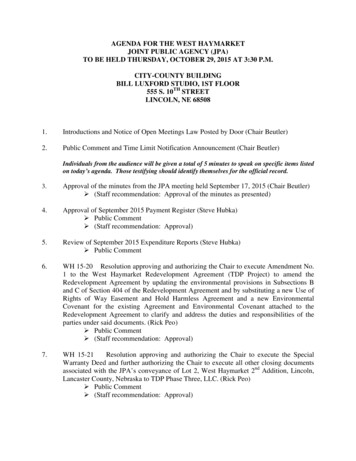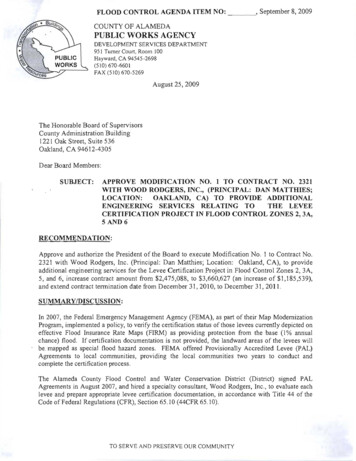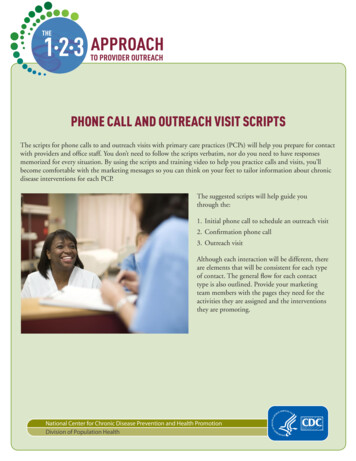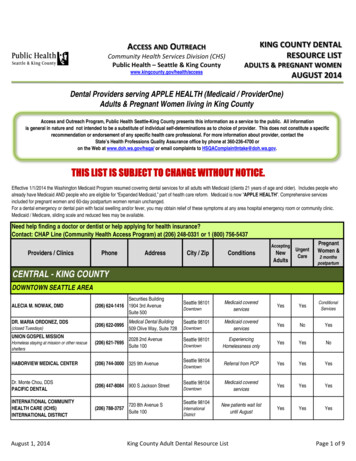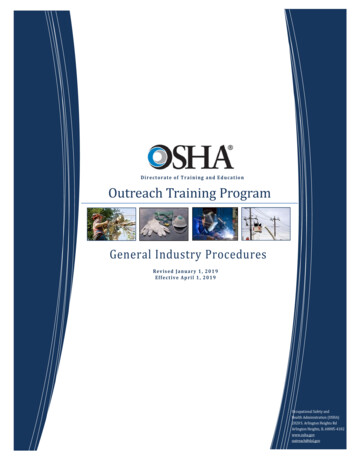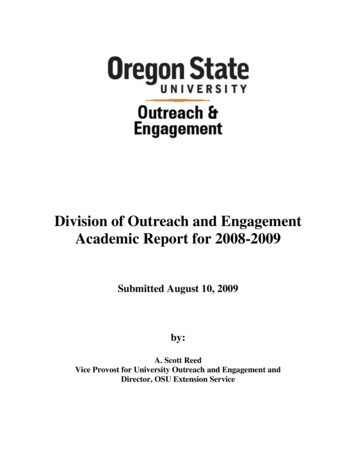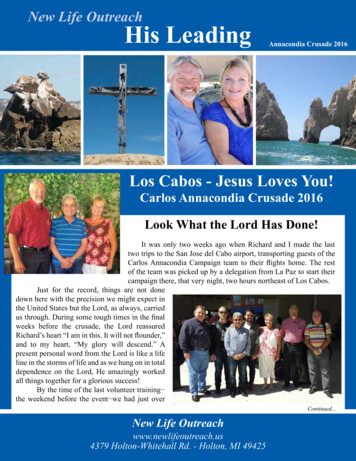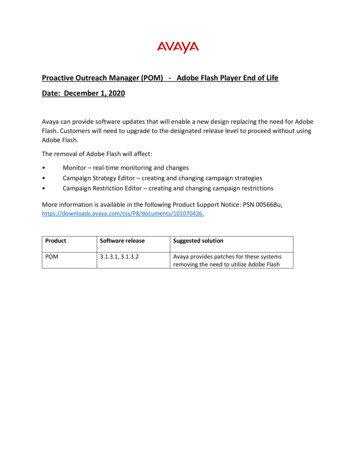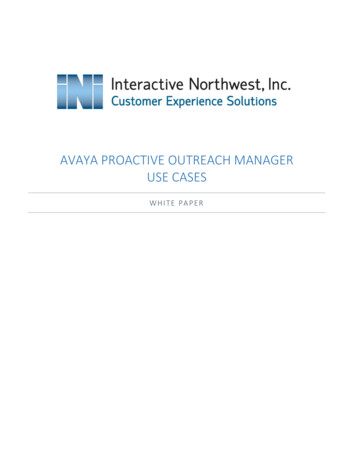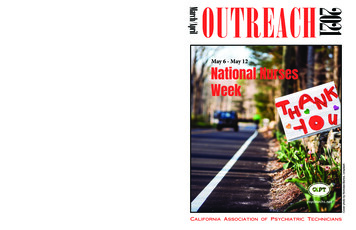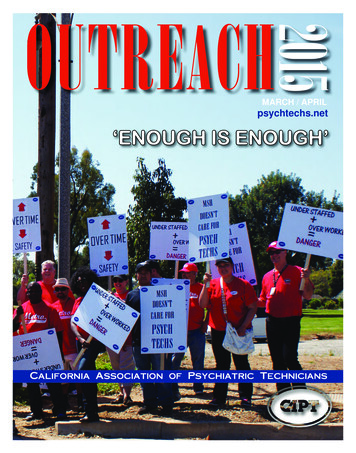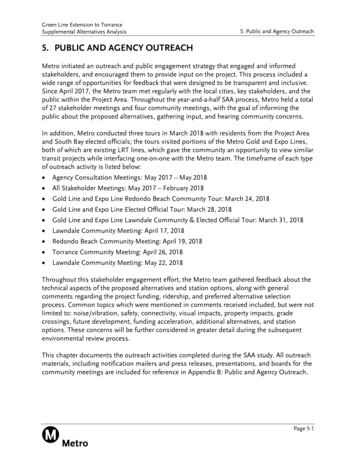
Transcription
Green Line Extension to TorranceSupplemental Alternatives Analysis5. Public and Agency Outreach5. PUBLIC AND AGENCY OUTREACHMetro initiated an outreach and public engagement strategy that engaged and informedstakeholders, and encouraged them to provide input on the project. This process included awide range of opportunities for feedback that were designed to be transparent and inclusive.Since April 2017, the Metro team met regularly with the local cities, key stakeholders, and thepublic within the Project Area. Throughout the year-and-a-half SAA process, Metro held a totalof 27 stakeholder meetings and four community meetings, with the goal of informing thepublic about the proposed alternatives, gathering input, and hearing community concerns.In addition, Metro conducted three tours in March 2018 with residents from the Project Areaand South Bay elected officials; the tours visited portions of the Metro Gold and Expo Lines,both of which are existing LRT lines, which gave the community an opportunity to view similartransit projects while interfacing one-on-one with the Metro team. The timeframe of each typeof outreach activity is listed below: Agency Consultation Meetings: May 2017 – May 2018 All Stakeholder Meetings: May 2017 – February 2018 Gold Line and Expo Line Redondo Beach Community Tour: March 24, 2018 Gold Line and Expo Line Elected Official Tour: March 28, 2018 Gold Line and Expo Line Lawndale Community & Elected Official Tour: March 31, 2018 Lawndale Community Meeting: April 17, 2018 Redondo Beach Community Meeting: April 19, 2018 Torrance Community Meeting: April 26, 2018 Lawndale Community Meeting: May 22, 2018Throughout this stakeholder engagement effort, the Metro team gathered feedback about thetechnical aspects of the proposed alternatives and station options, along with generalcomments regarding the project funding, ridership, and preferred alternative selectionprocess. Common topics which were mentioned in comments received included, but were notlimited to: noise/vibration, safety, connectivity, visual impacts, property impacts, gradecrossings, future development, funding acceleration, additional alternatives, and stationoptions. These concerns will be further considered in greater detail during the subsequentenvironmental review process.This chapter documents the outreach activities completed during the SAA study. All outreachmaterials, including notification mailers and press releases, presentations, and boards for thecommunity meetings are included for reference in Appendix B: Public and Agency Outreach.Page 5-1
Green Line Extension to TorranceSupplemental Alternatives Analysis5. Public and Agency Outreach5.1. EARLY ENGAGEMENT ACTIVITIES5.1.1. Stakeholder DatabaseThe Metro team developed a stakeholder database of over 1,000 contacts to initiate andcoordinate communication with the communities in and around the Project Area. Thestakeholder database for the project consisted of community leaders and key stakeholders inand around the Project Area, including agencies, neighborhood and community groups, civicclubs, industries, businesses, interfaith centers, elected officials, and the media. The databasewas managed in an Excel spreadsheet to store information, as well as in MailChimp to trackcorrespondence. The database was updated throughout the duration of the study with newcontacts from the project website, stakeholder meetings, and community meetings. Table 5.1summarizes the stakeholders contacted via the database.Table 5.1. Stakeholder Database SummaryStakeholdersQuantityCommunity Stakeholders1,124Elected Officials28Total1,152Source: The Robert Group, 20185.1.2. Fact SheetThe Metro team prepared a fact sheet that was provided to attendees at various outreachevents, including Agency Consultation Meetings. The fact sheet was updated throughout theduration of the study to provide the most current information on the project background,goals, history, next steps, as well as the project web page and contact information. The factsheet included information in both English and Spanish; see Appendix B.5.1.3. Project Information Telephone LineThe project information telephone line was set up and monitored regularly by the Metro team.The information telephone line, (213) 922-4004, was published in all communicationmaterials prepared for the Proposed Project. A total of 25 inquiries were received via theinformation line. Most of these inquiries did not comment directly on the project, and thosewith comments were asked to send comments in writing.5.1.4. Project E-mail BoxComments submitted via the project email address, greenlineextension@metro.net, weredocumented and logged into a master spreadsheet for project consideration. A total of 17comments were received via email (see Appendix B).Page 5-2
Green Line Extension to TorranceSupplemental Alternatives Analysis5. Public and Agency Outreach5.1.5. Project Web PageThe project web page, http://www.metro.net/projects/greenlineextension, was used as anavenue for notifying stakeholders about the community meetings, providing a resource forproject information (meeting presentation, fact sheet, and meeting notices), accessingcomment forms, and providing contact information. The web page is shown in Figure 5.1.Metro received 127 comments through the web page via Wufoo (see Appendix B). Themajority of comments were received after the start of the 2017 SAA process, but priorcomments received through the website were also considered.Figure 5.1. Proposed Project Web PageSource: Metro, 2018Page 5-3
Green Line Extension to TorranceSupplemental Alternatives Analysis5. Public and Agency Outreach5.2. AGENCY CONSULTATION MEETINGSSeven agency consultation meetings were conducted between May and September 2017, andone meeting was conducted in May 2018. At these meetings, Metro provided a presentationto the agencies that included an overview of the project, a description of the alternativesunder consideration, the timeline, and next steps.As shown in Table 5.2, the agency meetings included staff from the corridor cities and otherpublic and governmental organizations in the South Bay or other segments of the existingMetro Green Line.Table 5.2. Agency Consultation MeetingsMeeting DateAgenciesMay 10, 2017May 19, 2017June 1, 2017June 26, 2017July 12, 2017August 14, 2017City of Lawndale staffCity of Redondo Beach staffCity of Torrance and Torrance Transit staffCity of Lawndale staffSouth Bay Cities Council of GovernmentsSouth Bay Cities Council of Governments, Transportation CommitteeSeptember 13, 2017May 10, 2018South Bay Cities Council of Governments, Infrastructure Working GroupMetro Gateway Cities Service CouncilSource: The Robert Group, Metro, 2018Agencies were asked to provide input and feedback on the following topics: Alternatives within Metro ROW and Hawthorne Boulevard, as well as station options andgrade separation options Recent land use and transportation developments that may influence the Proposed Project Future land use and transportation projects that may influence the Proposed Project Identification of key stakeholders to include in the SAA outreach process Recommendations for successful public outreach activitiesThe following key takeaways were received from the agencies: Alternatives outside of Metro ROW – City of Lawndale requested Metro to explore othercorridor alternatives, including Hawthorne Boulevard, to serve the commercial corridorand address concerns or residents living along the Metro ROW. Environmental impact concerns – The Proposed Project should address concerns aboutenvironmental effects along the Metro ROW, namely regarding noise and vibration,preservation of green/recreational space, and residential and commercial property issues. Desired design options – The Proposed Project should examine a variety of differentdesign options, including cut-and-cover tunnels, trench and semi-trench alignments, atgrade alignments with mitigations (such as sound walls), and aerial alignments.Page 5-4
Green Line Extension to TorranceSupplemental Alternatives Analysis 5. Public and Agency OutreachInterest in multi-modal connections – The addition of bicycle paths along the Metro ROWshould be included, and would be viewed favorably by local bicycle advocates.5.3. STAKEHOLDER MEETINGSMetro conducted two rounds of stakeholder meetings in fall 2017 and in early 2018. Prior tothese meetings, the Metro team refined the alternatives based on the feedback receivedduring the agency consultation meetings. The stakeholder meeting attendees included electedofficials, local residents, community-based organizations, transit/bicycle advocates, businessgroups, and chambers of commerce.5.3.1. First Round of Stakeholder MeetingsThe first round of stakeholder meetings were conducted between September 12 andDecember 16, 2017. At these meetings, Metro provided a presentation that included anoverview of the project, a description of the alternatives under consideration, the timeline,and next steps. Table 5.3 provides a list of these meetings.Table 5.3. First Round of Stakeholder MeetingsMeeting DateStakeholdersSeptember 12, 2017South Bay Association Chamber of CommerceSeptember 14, 2017South Bay Bicycle CoalitionOctober 3, 2017South Bay Association of RealtorsOctober 11, 2017Torrance Chamber of Commerce, Government Affairs CommitteeOctober 12, 2017North Redondo Beach Business AssociationOctober 13, 2017Metro South Bay Service CouncilOctober 26, 2017South Bay Galleria, Forest City, QICDecember 16, 2017City of Redondo Beach Council District 3 Community MeetingSource: The Robert Group, Metro, 2018The following key takeaways were received from the first-round of stakeholder meetings: Environmental impact concerns – The Proposed Project should address concerns alongthe Metro ROW about potential property impacts and impacts to property values; loss ofparking; noise and vibration; safety; preservation of landscaping and/or green/recreationalspace; traffic; and construction impacts. Desired design options – The Proposed Project should examine a variety of differentdesign options, including cut-and-cover trench and semi-trench alignments, at-gradealignments with mitigations (such as sound walls), and aerial alignments. Interest in multimodal connections and regional connectivity – The Proposed Projectshould include multi-modal opportunities along the Metro ROW. Multi-modalPage 5-5
Green Line Extension to TorranceSupplemental Alternatives Analysis5. Public and Agency Outreachopportunities could include protected bike paths along the Metro ROW, with connectionsto existing paths, and more pedestrian walkways. The Proposed Project should provide aone seat ride to the Metro AMC 96th Street Transit Station that will connect to LAWA’sAPM system. Cost and funding options – Some of the stakeholder groups discussed options toaccelerate the Proposed Project, especially in time for the 2028 Olympics, and expressedconcerns with how funding for the Proposed Project will be formulated. Station design and access – The Proposed Project should consider potential stationdesigns, locations, and how patrons will access the stations, especially at the RedondoBeach TC and Torrance TC.5.3.2. Second Round of Stakeholder MeetingsThe second-round of stakeholder meeting activities were conducted between January 8 andFebruary 16, 2018. At these meetings, Metro provided a presentation that included asummary of the feedback received during the prior agency consultation meetings and thefirst-round of stakeholder meetings; an overview and comparison of the four Alternativesdeveloped based on stakeholder feedback; and next steps. Table 5.4 provides a list of thesemeetings. Figure 5.2 shows the presentation and group discussion at some of the stakeholdermeetings.Table 5.4. Second Round of Stakeholder MeetingsMeeting DateStakeholdersJanuary 8, 2018South Bay Cities Council of Governments, Transportation CommitteeJanuary 9, 2018South Bay Association Chamber of CommerceJanuary 10, 2018Torrance Chamber of Commerce, Government Affairs CommitteeJanuary 11, 2018North Redondo Beach Business AssociationJanuary 11, 2018City of Lawndale staffJanuary 11, 2018South Bay Bicycle CoalitionJanuary 12, 2018“Right of Say” community groupJanuary 25, 2018City of Torrance and Torrance Transit staffJanuary 25, 2018South Bay Cities Council of Government, Board of DirectorsFebruary 6, 2018South Bay Association of RealtorsFebruary 7, 2018City of Redondo Beach staffFebruary 16, 2018Redondo Beach Chamber of CommerceSource: The Robert Group, 2018Page 5-6
Green Line Extension to TorranceSupplemental Alternatives Analysis5. Public and Agency OutreachFigure 5.2. Stakeholder MeetingsSource: The Robert Group, Metro, 2018The following key takeaways were received from the second-round of stakeholder meetings: General support for the project – Most stakeholders saw a need for the Proposed Projectbut had issues with some of the alternatives, preferred one alternative over another,and/or had questions regarding specific property/visual impacts related to eachalternative. Project-related concerns – Stakeholders voiced concerns over costs, the length of theproject timeline, station locations, residential/property impacts, safety, parking, traffic,and differences between the alternatives. Identification of future funding sources – Stakeholders expressed interest in receivingmore information on the source of future funding, particularly for the more expensivealternatives. Opportunities for neighborhood improvements – Some of the agencies and stakeholdersexpressed interest in neighborhood improvements for all alternatives, including transitoriented development (TOD), multi-modal and pedestrian access, and green space. Concerns related to alternatives – Some local residents expressed concerns over using theMetro ROW as it runs through a residential area, whereas others were concerned aboutproperty and traffic impacts related to the proposed alternatives along HawthorneBoulevard.Page 5-7
Green Line Extension to TorranceSupplemental Alternatives Analysis5. Public and Agency Outreach5.4. COMMUNITY TOURSCommunity tours were scheduled to offer South Bay residents and elected officials anopportunity to see first-hand examples of the currently operating Metro Expo and Gold Lines,and how they integrate with the surrounding communities. Tours were offered for residents ofLawndale and Redondo Beach on March 24 and March 31, 2018 and for elected officials onMarch 28, 2018.Door-to-door flyers were utilized to invite the community to the tours and were delivered toapproximately 3,500 project stakeholders on March 3, March 9, and March 12, 2018. Theflyers informed the community of the community tours and the request for input on theproject. A copy of the flyer is provided in Appendix B.A total of 73 residents and elected officials attended the tours, as shown in Table 5.5.Table 5.5. Summary of Community ToursDateTourAttendeesMarch 24, 2018City of Redondo Beach Residents29March 28, 2018South Bay Elected Officials8March 31, 2018City of Lawndale Residents & Elected36OfficialsTotal73Source: The Robert Group, 2018During the tours, Metro provided informational packets to the tour attendees, which includedagendas, presentations, fact sheets, and information on the Metro system (included inAppendix B).The Metro team engaged with the tour attendees along the tour route, as shown in the photosin Figure 5.3. The tours highlighted LRT elements such as grade crossings, soundwalls,landscaping, and trench alignments, as well as the context of LRT integration withcommunities of varying types and sizes. Participants were encouraged to attend thecommunity meetings in April 2018, and to share the information provided with the rest oftheir community.Page 5-8
Green Line Extension to TorranceSupplemental Alternatives Analysis5. Public and Agency OutreachFigure 5.3. Community ToursSource: The Robert Group, Metro, 2018The following key takeaways were received from the community tour participants: General support of Metro rail projects – Most of the attendees expressed interest in andgeneral approval of the Metro Gold and Expo Line elements viewed on the tour, especiallyrelating to integration with the local communities, mitigated environmental impacts, suchas sound walls, safety features, and accessibility, and TOD. Some attendees expressedopposition to the Proposed Project. Environmental impact concerns – Some attendees voiced concerns about impacts toresidential neighborhoods, such as noise/vibration, grade crossings, safety, visualimpacts, and property values. Interest in future tour opportunities – Many attendees expressed a desire to participate infuture tours offered by Metro.Page 5-9
Green Line Extension to TorranceSupplemental Alternatives Analysis5. Public and Agency Outreach5.5. COMMUNITY MEETINGSFour community meetings were held in spring 2018 to provide updates to the community,and to solicit feedback.5.5.1. Community Meeting NoticesTargeted outreach was conducted to stakeholders via direct mail, door-to-door flyers, email(e-blasts), and social media and posts leading up to the community meetings.5.5.1.1.Direct MailInformational mailers were mailed to 15,681 project stakeholders on April 9, April 11, andMay 11, 2018. The mailers informed the community of the community meetings and therequest for input on the Proposed Project alternatives. The information was provided in bothEnglish and Spanish. The areas where mailers were sent are shown in Figure 5.4. A copy ofthe direct mailers is provided in Appendix B.5.5.1.2.Email NotificationsA total of five email notices (e-blasts) were sent out prior to the community meetings utilizingthe project database with email addresses of over 1,100 stakeholders. Following thecommunity meetings, an additional “thank you” email notice was sent out to stakeholderswho attended with a reminder of the opportunity to submit comments. The email provided alink to the project website and the methods to provide public comments. A copy of the emailnotification is provided in Appendix B.5.5.1.3.FlyersCommunity meeting flyers were delivered door-to-door to approximately 8,500 projectstakeholders on April 10, April 12, April 13, April 18, May 17, and May 18, 2018. The flyersinformed the communities of the dates and locations of the community meetings and therequest for input on the project. As with other notification materials, the information wasprovided in bilingual format. The areas where flyers were delivered are shown in Figure 5.4. Acopy of the flyer is provided in Appendix B.Page 5-10
Green Line Extension to TorranceSupplemental Alternatives Analysis5. Public and Agency OutreachFigure 5.4. Areas Targeted for Community Meeting NoticesSource: STV, The Robert Group, Metro, 2018Page 5-11
Green Line Extension to TorranceSupplemental Alternatives Analysis5.5.1.4.5. Public and Agency OutreachSocial MediaFacebook was used to promote the community meetings by posting meeting information andsending reminder notices to followers. Metro Marketing published ads on Facebook targetedto the residents of Torrance, Lawndale, and Redondo Beach from April 10 to April 26, 2018.Approximately 125,309 people were reached with the ad; and the campaign was viewed337,113 times overall. On the Facebook page, 1,095 people responded that they wereinterested or planning to attend the event;5.5.2. Community Meeting Dates and LocationsTable 5.6 describes the dates, locations, and approximate attendance at the four communitymeetings, which were attended by local residents and elected officials. The locations of allcommunity meetings are shown in Figure 5.5. Two meetings were held in Lawndale. This wasbecause Metro revised the meeting format in response to feedback received from the firstcommunity meeting in Lawndale on Tuesday, April 17, 2018, where a formal public commentperiod after the presentation was not scheduled. In order to provide an additional av
Throughout the year-and-a-half SAA process, Metro held a total of 27 stakeholder meetings and four community meetings, with the goal of informing the public about the proposed alternatives, gathering input, and hearing community concerns. . The information telephone

